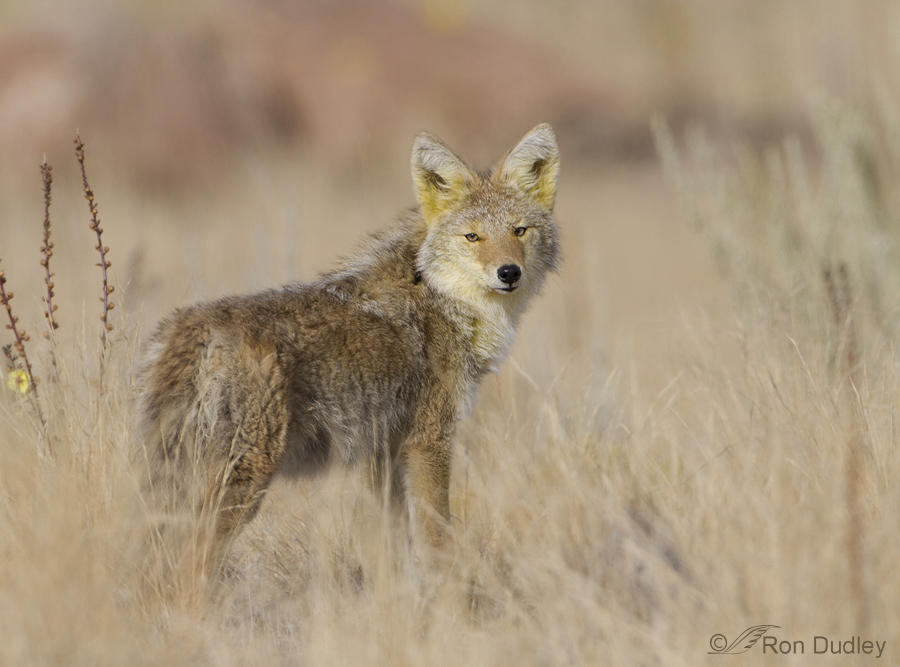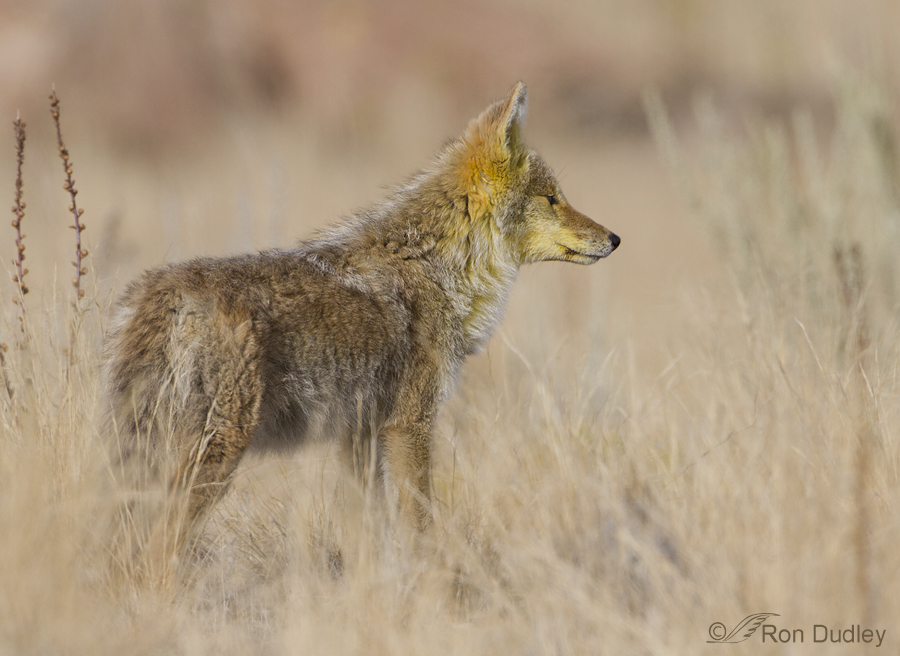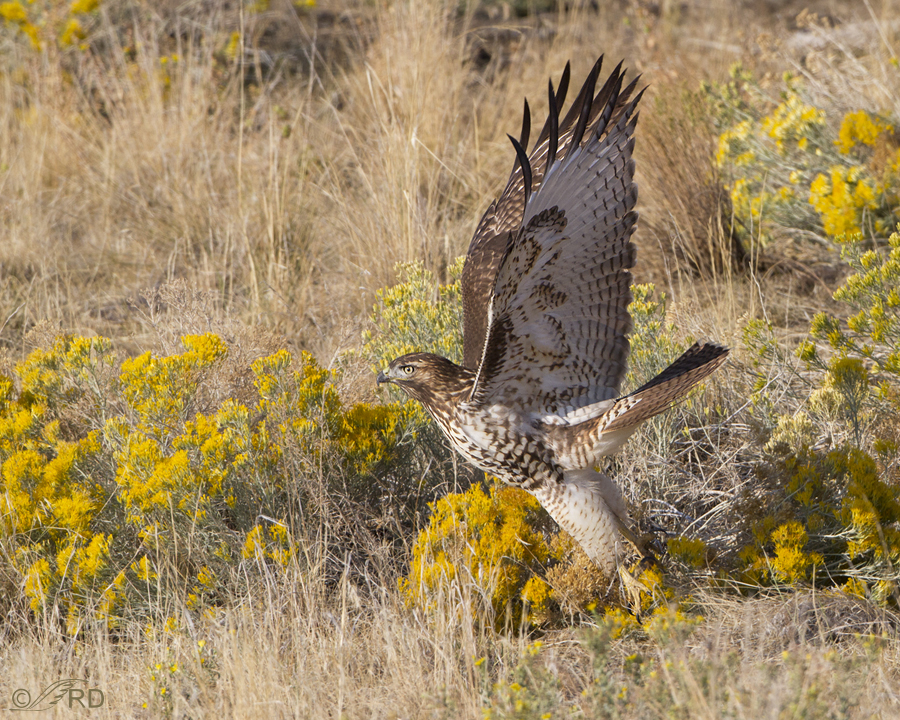Don’t ask me how it happened. I’m still trying to figure it out.
We ran into two yellow-stained coyotes on Antelope Island this morning – this adult and a youngster. They were traveling together and both were stained bright yellow on parts of their faces and ears.
This view shows the staining behind the mouth and ears better. The yellow was even brighter and more obvious than it appears in these photos.
This time of year the island is awash in yellow – from sunflowers, the last of the mullein and from rabbit brush. Lots of rabbit brush! I dug out this shot to show you what the rabbit brush looks like in bloom (taken about the same time last year).
My initial assumption was that the staining was rabbit brush pollen that got on the coyotes when they rooted at the base of a plant for prey or carrion. But I got out of my truck and tested several plants by rubbing their flower clusters in my hand to see if they left any yellow pollen behind. They didn’t (but man, do those flowers ever stink! Believe me, there’s good reason for the species name “nauseosa”). Mia did the same thing with sunflowers – nothing significant. There’s not enough mullein blossoms left to even be considered the source (you can see one lonely remnant mullein flower to the left of the frame in the first image).
So I’m stumped. My best guess is that it was rabbit brush pollen and that there were areas of those plants on the island that were more actively producing pollen than the ones I checked. Rabbit brush pollen is the bane of many allergy sufferers throughout the west so it must produce lots of it.
Whatever the cause, seeing yellow coyotes certainly got my attention.
Ron





Amazing photos!
They heard that a couple of preeminent Nature photographers were in the area and they applied their best makeup in preparation for a session.
I sort of lean with Bill’s explanation as I can visualize them gorging within a carcass to produce the stain pattern. But I sure don’t know! Very interesting stuff you find!
Ron, I suspect Bill’s first impression, “sticking their heads in a carcass”, is the more likely source of the yellow coloration. Dining on liver and gall bladder could account for the yellow color. I noticed that there appears to be dark dried blood on the lower lip of the coyote in the second photo. Also, the ear tips do not appear to be stained yellow suggesting the face and neck were deep in the carcass and the ears poking out to alert the animal if something/someone were to approach him while enjoying his pâté.
Yellow-headed black bird…yellow-head coyote…could it be the Midas touch?
Patty, thank you for a good laugh! I love your theory.
Fascinating. And it did make me think of the dye that is put into some bank vaults and ATMs to explode and shower the culprit if they are broken into.
I will be interested to hear if you get a definitive answer about the yellow peril…
Well Coyotes are certainly plentiful here but they are not something I study in great detail. I suspect the answer is the plant you suggested Ron but in doing so I suspect you and Mia didn’t rub the rabbit brush in your “hair”. My first assumption was that it came from sticking their heads in a carcass but the plant coloration is just too coincidental.
BTW not sure if some here may be aware but there is a Coyote-Wolf hybrid found in several areas of (mostly eastern US)NA.
Bill
“I suspect you and Mia didn’t rub the rabbit brush in your “hair””
Ha, wouldn’t work for me, Bill – don’t have enough of it…:)
More amazing pictures. The coyotes are beautiful. No other reports of coyotes with yellow stains?
Not that I’m aware of, Ellen.
Wow! That’s amazing! Pollen would have been my guess as well. Hummm….. Great shots!The hawk is magnificent as well!
Charlotte
Thanks, Charlotte.
That’s the color my dogs seem to have when they find cow dung and roll in it. The color of the dung is dark brown, but when its thinned out on the fur, and drier, it takes on a yellowish(summer), or greenish (winter) color. Its not a daily occurance, but they seem to enjoy rolling in the dang stuff. lol.
Not sure what your coyote has here, but does kinda remind me of it.
But having said that…..the coloring is so even on both sides, you may have found a specimen that just has more yellow than redish yellow.
Tim
Tim, I remember dogs doing the same thing on our Montana farm.
“the coloring is so even on both sides, you may have found a specimen that just has more yellow than redish yellow”
But there were two coyotes together and they both had similar yellow colors on their faces and ears…
I just read an article that answered a question similar to this. said that coyote’s fur can be reflect more red or yellow with the angle of the sun….hmmmmmm. sounded like he was guessing too. lol
Tim
“…Another aspect of coloration, or at least the perception of color, is the light. At
different times of the day, different seasons of the year and due to various
climatic conditions, the quality of light is different. When the sun is lower in the
sky it is often “redder”; if you saw the coyotes when the sun was low, or when
something else had changed the apparent color of sunlight, the coyotes may
have appeared to be more golden than on some other day.” Ranger Richard E. Bicknell
An interesting possibility, Tim…
Very interesting photos. BTW, with a smell like that the rabbit brush is most likely usually pollinated by flies. I know the last photo is to demonstrate rabbit brush, but I am captivated by the pattern on the hawks wings.
Well, there’s plenty of flies of a variety of species on the island, Susan (and lots of the little buggers bite!) 🙂
Here’s what one source says about rabbit brush and pollinators.
“Rubber rabbitbrush attracts a wide array of native insects, including butterflies and small bees (Utah Native Plant Society 2009; Ogle et al. 2007). It is one the few native plant species in the Intermountain West that provides habitat for pollinators during the late summer and fall months (Ogle et al. 2007).”
Beautiful shots of the coyote as pollinator. Years ago I saw a coyote crossing a local field and got a godawful, distant little photo. Even so, it was used by a group in favor of importing coyotes into Valley Forge National Historic Park to control the deer population there. The Park went with controlled hunts instead. Gorgeous photos!
Thanks, Kelly. Last year Utah enacted a very expensive coyote bounty system (euphemistically called the “Mule Deer Protection Act)in a misguided effort to increase deer herds, despite the fact that scientific studies indicate that such programs have no such effect on Mule Deer numbers. Thankfully, Antelope Island is a state park and coyote hunting is not allowed there.